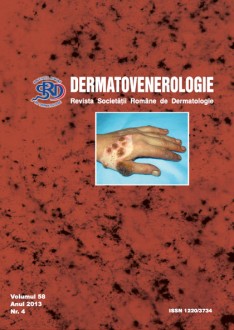Keratoacanthoma is a cutaneous lesion, characterised by rapid growth and spontaneous involution, occurring most commonly on the sun-exposed skin areas of middleaged and elderly people.
Multiple keratoacanthomas were described as part of genetic syndromes (generalised eruptive keratoacanthomas of Grzybowski, disseminated multiple keratoacanthomas of the Ferguson-Smith type, keratoacanthomas of Witten and Zak) as a result of different types of traumas, prolonged exposure to chemical carcinogens (tars, resins) or
secondary to other dermatoses (post-herpes zoster, discoid lupus erythematosus, psoriasis, pemphigus foliaceus,lichen planus, atopic dermatitis, acne conglobata, vitiligo etc.).
We present the case of a 36-year-old female patient, who came to the clinic for multiple lesions with an exophytic verrucous surface, associated with erythematous and hypopigmented plaques located on the sun-exposed areas, which had started approximately 18 months before.
Biopsies were performed for both types of lesions that evidenced keratoacanthoma-type changes and respectively discoid lupus.
Under treatment with medium potency dermocorticoids (for lupus), and keratolytic creams and cryotherapy (for keratoacanthomas), the evolution was favourable, with partial remission of lesions.
Clinical cases
MULTIPLE KERATOACANTHOMAS ASSOCIATED WITH CHRONIC LUPUS ERYTHEMATOSUS - CASE RESENTATION


